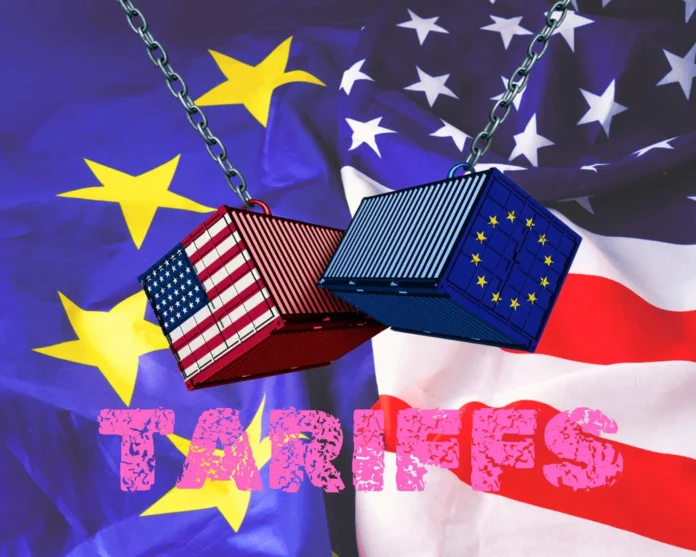EU Tariffs on US Goods: The EU’s Swift Response to U.S. Tariffs
In a swift retaliatory move, the European Union has announced fresh tariffs on U.S. industrial and agricultural products. This action follows an increase in U.S. tariffs on all steel and aluminum imports, raising them to 25%. While the EU had anticipated such measures, this latest escalation puts further strain on already fragile transatlantic relations.
The tariffs will impact $28 billion worth of U.S. goods, extending beyond steel and aluminum to include textiles, home appliances, and agricultural products. Additionally, items such as motorcycles, bourbon, peanut butter, and jeans—which were previously targeted during former President Donald Trump’s first term—will once again be affected. These measures signal a strong stance from the EU in response to what it views as unfair trade practices.
The Targeted Approach of EU Tariffs
The EU has strategically structured its countermeasures to exert pressure on key U.S. industries while minimizing domestic economic repercussions. Notably, the tariffs focus on goods from Republican-led states, affecting commodities such as soybeans, beef, poultry, and produce across regions like Louisiana, Kansas, Nebraska, Alabama, Georgia, and Virginia.
Beyond agricultural products, the manufacturing and automotive sectors will also feel the pinch, as EU leaders aim to rebalance trade relations while discouraging further unilateral actions by the U.S. Many industry analysts argue that these tariffs could create ripple effects across global supply chains, impacting manufacturers, exporters, and consumers worldwide.
The EU’s Stance: Open to Negotiation

European Commission President Ursula von der Leyen emphasized the EU’s willingness to negotiate but stressed the need for balanced trade measures. Highlighting the economic risks involved, she noted that tariffs often lead to higher prices, job losses, and disrupted supply chains on both sides of the Atlantic.
“As the U.S. applies tariffs worth $28 billion, we are responding with countermeasures worth €26 billion,” von der Leyen stated, reinforcing that trade conflicts only add to global economic uncertainty.
As a result, European diplomats have sought alternative pathways to de-escalate tensions, proposing trade forums and bilateral discussions. However, as history suggests, trade disputes of this scale rarely resolve quickly and often lead to prolonged economic consequences.
The Business Community’s Concerns
American businesses operating in Europe have expressed deep concern over the impact of these tariffs. The American Chamber of Commerce to the EU urged both sides to seek a negotiated resolution, warning that prolonged trade disputes could harm businesses, jobs, and overall economic stability.
“The two sides must de-escalate and find a negotiated outcome urgently,” the chamber stressed in a recent statement.
Several multinational companies are already bracing for potential disruptions in supply chains and increased production costs, with some firms even considering shifting production outside of affected regions. Small and medium-sized enterprises (SMEs) are expected to be hit hardest, as they have fewer resources to absorb additional costs.
What Comes Next in the Trade Conflict?
This retaliatory action follows a familiar pattern from Trump’s first term, during which the EU imposed similar countermeasures on U.S. exports. However, this time, the EU has outlined a two-step process for implementation:
- April 1: The reintroduction of previously suspended “rebalancing measures” from 2018–2020.
- April 13: Additional tariffs targeting €18 billion ($19.6 billion) in U.S. exports.
Despite last-minute diplomatic efforts, EU Trade Commissioner Maroš Šefčovič noted that discussions with U.S. officials yielded no resolution, stating that meaningful negotiation requires cooperation from both sides.

“I argued to avoid the unnecessary burden of measures and countermeasures, but you need a partner for that. You need both hands to clap,” Šefčovič remarked, underscoring the challenges of reaching a diplomatic solution.
The Economic Impact on European Steel Industry
The European steel sector is bracing for a significant blow, with potential losses amounting to 3.7 million tons of steel exports. The U.S. currently serves as the second-largest market for EU steel producers, accounting for 16% of total exports.
As the situation unfolds, steel manufacturers across Europe are lobbying their governments to seek a diplomatic solution that avoids further economic strain. Some industry insiders warn that prolonged tariffs could lead to job losses, plant closures, and a slowdown in industrial investment. Additionally, economic analysts highlight that this trade conflict may drive higher costs for construction and infrastructure projects, which rely heavily on steel imports.
The Bigger Picture: EU-U.S. Trade Relations
With annual trade between the two economies valued at approximately $1.5 trillion, both sides stand to lose from prolonged tariff conflicts. While the EU maintains a trade surplus in goods, the U.S. enjoys an advantage in services, creating a complex trade balance.
Meanwhile, the UK has chosen a different approach, opting not to impose retaliatory tariffs for now. British Business Secretary Jonathan Reynolds indicated that while Britain will continue diplomatic discussions, it remains open to potential trade measures in the future.
Additionally, other global trading partners, including China, Canada, and Mexico, are closely monitoring the situation. If tensions continue to escalate, more countries may be drawn into a wider trade dispute, further disrupting international markets.
Final Thoughts
As the EU and U.S. remain locked in a trade standoff, businesses and consumers on both sides will bear the economic consequences. Whether negotiations will eventually ease tensions remains uncertain, but for now, the world watches as two of the largest economies navigate yet another trade dispute.
Industry leaders and economic analysts warn that unless both sides find a compromise, global markets could experience heightened volatility, further impacting businesses and consumers worldwide. The outcome of these tariffs could set a precedent for future trade policies and international economic relations, making it a critical issue to watch in the coming months.


